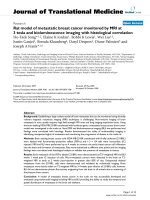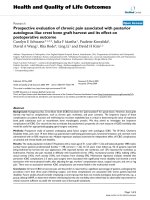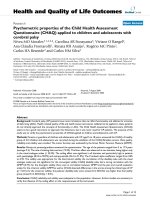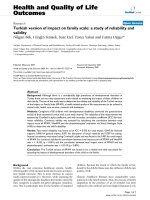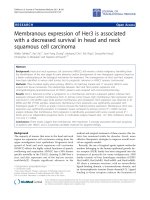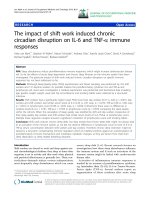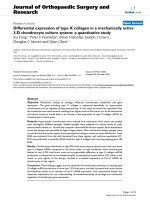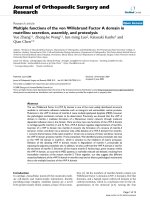báo cáo hóa học:" Membranous expression of Her3 is associated with a decreased survival in head and neck squamous cell carcinoma" doc
Bạn đang xem bản rút gọn của tài liệu. Xem và tải ngay bản đầy đủ của tài liệu tại đây (650.03 KB, 10 trang )
RESEARCH Open Access
Membranous expression of Her3 is associated
with a decreased survival in head and neck
squamous cell carcinoma
Mikiko Takikita
1†
, Ran Xie
1†
, Joon-Yong Chung
2
, Hanbyoul Cho
1
, Kris Ylaya
1
, Seung-Mo Hong
3
,
Christopher A Moskaluk
4
and Stephen M Hewitt
1,2*
Abstract
Background: Head and neck squamous cell carcinoma (HNSCC) still remains a lethal malignancy benefiting from
the identification of the new target for early detection and/or development of new therapeutic regimens based on
a better understanding of the biological mechanism for treatment. The overexpression of Her2 and Her3 receptors
have been identified in various solid tumors, but its prognostic relevance in HNSCC remains controversial.
Methods: Three hundred eighty-seven primary HNSCCs, 20 matching metasis and 17 recurrent HNSCCs were
arrayed into tissue microarrays. The relationships between Her2 and Her3 protein expression and
clinicopathological parameters/survival of HNSCC patients were analyzed with immunohistochemistry.
Results: Her3 is detected as either a cytoplasmic or a membranous dominant expression pattern whereas Her2
expression showed uniform membranous form. In primary tumor tissues, high membranous Her2 expression level
was found in 104 (26.9%) cases while positive membranous and cytoplasmic Her3 expression was observed in 34
(8.8%) and 300 (77.5%) samples, respectively. Membranous Her2 expression was significantly associated with
histological grade (P = 0.021), as grade 2 tumors showed the highest positive expression. Membranous Her3 over-
expression was significantly prevalent in metastatic tissues compared to primary tumors (P = 0.003). Survival
analysis indicates that membranous Her3 expression is significantly associated with worse overall survival (P =
0.027) and is an independent prognostic factor in multivariate analysis (hazard ratio, 1.51; 95% confidence interval,
1.01-2.23; P = 0.040).
Conclusions: These results suggest that memb ranous Her3 expression is strongly associated with poor prognosis
of pat ients with HNSCC and is a potential candidate molecule for targeted therapy.
Background
The majority of tumors that arise in the head and neck
region are s quamous cell carcin omas arising from the
upper aerodigestive tract epithelium. Progressive local
spread of head and neck squamous cell carcinoma
(HNSCC) affects the highly critical functions of speech,
swallowing and respiration. HNSCC has a 50% disease
specific mortality in the USA[1], claiming 11,000 lives a
year, and also represents one o f the top ten cancers
worldwide[2]. Despite significant advances in the
medical and surgical treatment of these cancers, this sta-
tistic has remained stable for decades. Novel, more
effective therapeutic strategies to improve overall survi-
val are urgently needed.
Recently, the use of targeted agents again st molecular
markers belonging to the human epider mal growth fac-
tor receptor (HER) family has been integrated into the
treatment of protocols for many malignancies. HER
family consists of four homologue members (EGFR/
Her1/erbB1, Her2/erbB2, Her3/erbB3, and Her4/erbB4).
All share a common structure, with an extracellular
ligand-binding domain, a transmembrane domain, and
an intracytoplas mic tyrosine kinase domain[3-5]. Ligand
binding to these receptors induces the formation of
* Correspondence:
† Contributed equally
1
Tissue Array Research Program, Laboratory of Pathology, National Cancer
Institute, National Institutes of Health, Bethesda, MD 20892, USA
Full list of author information is available at the end of the article
Takikita et al. Journal of Translational Medicine 2011, 9:126
/>© 2011 Takikita et al; licensee BioMed Central L td. This is an Open Access article distributed under the terms of the Creative Commons
Attribution License ( censes/by/2.0), which permits unrestricted use, di stribution, and reproduction in
any medium, provided the original wor k is properly cited.
receptor homodimers and heterodimers, and thereby
activates numerous downstream pathways regulating
diverse processes including differentiation, migration,
proliferation, and survival.
Her2 has an extracellular domain, but appears to lack
ligand-binding activity, while Her3 has a non-functional
kinase domain and has no catalytic activity. Her2-Her3
function by formation of a heterodimeric complex
which actives an oncogenic signaling pathway (e.g. PI3/
AKT pathway)[6]. Even in its over -expressed and onc o-
genic state Her2 does not escape its dependency on
HER family partners, and He r3 plays an important a nd
necessary function in Her2-mediated tumorigenesis[7].
As the HER pathway contributes significantly to pro-
gression of cancers, its family members serve as a group
of anti-cancer drug target with great clinical potential.
Current therapeutic efforts against the HER family are
focused on small molecule tyrosine kinase inhibitors
(TKIs) and humanized or chimeric monoclonal antibo-
dies (mAbs)[8,9]. Recent studies revealed that Her3 is
the principle mediator of TKI resistance. TKIs effectively
prevent auto-phosphorylation of EGFR and Her2 in
tumor cells, however, the transphosphorylation of Her3
is only transiently suppressed and Her3 ultimately
escapes inhibition by TKIs in Her2 over-expressing
tumor cells[10]. Consequently, the Her3 resistance
causes PI3/Akt pathway resistance, tumor survival, and
escape from proapo ptotic consequences of the loss of
oncogenic Her2 signaling.
Her2 over-expression in HNSCC has been reported,
[11] but there are few studies on Her3 expression in
HNSCC[12]. Clinical studies with agents targeting HER
proteins have been per formed in patients with HNSCC,
with promising results[13-15]. However, the prognostic
significance and the potential as biomarkers of Her2 and
Her3 in HNSCC remains undetermined. In the present
study, protein expression levels of Her2 and Her3 were
interrogated on a tissue microarray (TMA) of surgically
removed samples of HNSCC by immunohistochemistry
(IHC). The relationships between protein expression
and clinicopathological parameters/survival of HNSCC
patients were also analyzed.
Materials and methods
Patients and tumor samples
A total of four hundred twenty four formalin fixed and
paraffin embedded tumor specimens with HNSCC were
obtained from the archives of the Pathology Department
of the University of Virginia Health System and were
assembled into TMA blocks containing: 387 primary
HNSCC tissues, 20 matching metastatic tissues an d 17
recurrent HNSCC tissues. The clinical information of
these patients was obtained from the University of
Virginia Cancer Registry. Material was obtained with
appropriate human protection approvals from the insti-
tutional review board of University of Virginia Health
System and office of Human Subjects Research at the
NIH. Information on post-operative radiation and/or
chemotherapy, a nd performance status of patients was
unavailable for analysis.
Tissue microarray construction
TMAs were constructed from archival formalin fixed,
paraffin embedded tissue blocks. For each tumor, a
representative tumor area was carefully selected from a
hematoxylin a nd eosin stained section of a donor block
which as previously described[16]. Four 0.6 mm dia-
meter cores were retrieved from selected regions of
donor blocks from each case and tr ansplanted to the
recipient block using a manual tissue arraye r (Beecher
Instruments, Silver Spring, MD). Multiple 5-μmthick
sections were cut with a microtome and H&E staining
of TMA slides were examined every 50
th
sections for
the presence of tumor cells.
Western blot analysis of Her3 antibody
For three cell lines, A549, MCF7 and BxPC3, a total 4 ×
10
7
cells were rinsed twice with ice-cold PBS and added
0.5 ml of the Protein Extraction Solution RIPA (Pierce
Biotechnology, Rockford, IL). After incuba tion for 30
min on ice, cells were scraped and centrifuged. Protein
concentrations were measured by the BCA protein assay
kit (Pierce B iotechnology). To determine the specificity
of anti-Her3 antibody, 30 μg of protein were separated
by 4-12% NuPAGE
®
Novex Bis-Tris polyacrylamide gel
electrophoresis and transferred to nitrocellulose mem-
brane ( Invitrogen, Carlsbad, CA). The membranes were
blocked with 5% nonfat dry milk in TBST (50 mM Tris,
pH 7.5, 150 mM NaCl, 0.05% Tween-20) for 1 h,
wash ed, and subsequen tly incubated overnight at 4°C in
TBST with 5% BSA containing anti-Her3 antibodies
(RTJ.2, mouse monoclonal; Santa Cruz Biotechnology,
Santa Cruz, CA; dilution 1:1000). Her3 expressional sig-
nals were detected with horseradish peroxidase-labeled
anti-mouse antibodies (Chemicon International) and
enhanced with SuperSignal Chemiluminescence kit
(Pierce Biotechnology).
Immunohistochemistry and scoring
To investigate the significance of Her2 and Her3 expres-
sion in HNSCC, 4-micron histologic sections of the
TMAs were stained by IHC. Briefly, tissue sections were
deparaffini zed and hydrated in xylene and serial alcohol
solutions, respectively. Endogenous peroxidase was
blockedbyincubationin3%H
2
O
2
for 10 min. Antigen
retrieval was pe rformed in a steam pressure cooker with
Takikita et al. Journal of Translational Medicine 2011, 9:126
/>Page 2 of 10
prewarmed antigen retrieval buffer pH 6 (DakoCytoma-
tion, Carpinteria, CA) at 95°C, for 10 min and 40 min,
for Her3 and Her2 staining respectively. To minimize
non-specific staining, the section was incubated with
protein block (DakoCytomation) for 15 min. After wash-
ing with TBST, the specimen was incubated with anti-
Her3 antibodies (RTJ.2, mouse monoclonal; Santa Cruz
Biotechnology, Santa Cruz, C A; dilution 1:500) over-
night at 4°C, anti-Her2 antibod ies (c-erbB2, A0485, rab-
bit polyclonal: Dako; dilution 1:750) at room
temperature for 30 min. Antigen-antibody reactions
were detected w ith DAKO LSAB
®
+ p eroxidase kit
(Dako). The stain visualized using 3,3’-diaminobenzidine
plus (Dako) and was lightly counterstained with hema-
toxylin, dehydrated in ethanol, an d cleared in xylene.
Appropriate negative controls were concurrently per-
formed, and the TMAs included appropriate positive
control tissues. The slides were covered and observed
under a light microscope (Axioplot, Carl Zeiss, Jena,
Germany). Her3 assessment included manual qualitative
interpretation of both membranous and cytoplas mic
staining. Her2 (membranous) staining a nd Her3 me m-
branous staining were scored according to the com-
monly applied criteria of Her2 membranous staining (0,
+1, +2, +3) and further dichotomized as either negative
(score 0) or positive (+1, +2, or +3)[17]. For assessment
of Her3 cytoplasmic staining, two scores were assigned
to each core. (a) the staining intensity [categorized as 0
(absent), 1 (weak), 2 (moderate), or 3 (strong)] and (b)
the percentage of positively stained epithelial cells
[scored as 0 (0% positive), 1 (1-25%), 2 (26-50%), 3 (51-
75%), and 4 (76-100%)]. An overall protein expression
score was calculated by multiplying the intensity and
positivity scores (overall score range, 0-12). This overall
score for each patient was further simplified by dichoto-
mizing it to negative (overall score < = 3) or positive
(score of > = 4). Consensus review by two pathologist
(MT and SMH) was conducted.
Statistical analysis
The Chi-square test was applied to test the possible
association between the expression of Her2/Her3 and
the clinicopathologic parameters. The Mann-Whitney
U-test was used for the analysis of the relationship
between Her2/Her3 expression and the patient’sage.
Kaplan-Meier curves were plotted to assess the effect of
Her2/Her3 expression on overall survival. Diff erent sur-
vival curves were compared using the log-rank test.
Multivariate proportional Cox models were applied to
assess the prognostic significance of Her2, Her3, primary
tumor sites, histological grading, gender and age. P<
0.05 was regarded as statistically significant. All statisti-
cal analyses were performed using the SPSS for Window
(16.0) package (SPSS, Chicago, IL).
Results
Clinicopathological features of patients
Clinicopatho logical charact eris tics of cases are summar-
ized in Table 1. The ages of the patients ranged from 20
to 95 years (mean, 61 years). Two hundred and ninety
two patients were men and 94 were women. Eighty nine
cases were grade 1 tumors, 230 grade 2 and 59 grade 3.
Approximately 90% of the patients were ei ther laryngeal
or oral cancers. The majority of metastatic tissues
(85.0%) were obtained from lymph nodes showing meta-
static spread from primary HNSCC. Information about
tumor staging was not available for this study group.
Expression of Her2 and Her3
We performed western blotting in three cell lines (A549,
BxPC3 and MCF7) to verify the specificity and capability
of the anti-Her3 antibodies. Western blotting experi-
ments showed that of the three cell lines tested, MCF7
cells had high levels of Her 3, BxPC3 cells had inter-
mediate Her3, and A549 cells had low Her3 (Figure 1).
We analyzed the expression pattern of Her2 and Her3
proteins using IHC in 424 tumor samples. Twenty
patients were represented by both primary tumors as
well as metastatic lesions. H er2 was expressed exclu-
sively in the cell membrane (Figure 2a). Her3 staining
was observed i n the both cell membrane and cytoplasm
Table 1 Characteristics of Patients
Variables Number (%)
Primary tumor 387 (100)
Age
Median 61
Range 20 - 95
Gender
Male 292 (75.5)
Female 95 (24.5)
Tumor sites
Larynx 183 (47.3)
Oral cavity 157 (40.6)
Pharynx 23 (5.9)
Nasal cavity 16 (4.1)
Salivary gland 8 (2.1)
Histological grading
Grade 1 89 (23.5)
Grade 2 230 (60.8)
Grade 3 59 (15.7)
Lymph node metastasis
No 363 (95.8)
Yes 16 (4.2)
Metastatic tumor 20 (100)
Lymph node 17 (85.0)
Salivary gland 3 (15.0)
Recurrent tumor 17 (100)
Takikita et al. Journal of Translational Medicine 2011, 9:126
/>Page 3 of 10
(membranous staining; Figure 2b) or predominantly in
the cytoplasm (cytoplasmic staining; Figure 2c). Negative
control sections demonstrated no staining (data not
shown). Her2 staining was scored based on the scoring
system applied to breast cancers, with scores of 0,+1,
+2, +3 for increas ing intensity and “ continuity” of stain-
ing of the cell membrane[17]. For quantification of Her3
staining, we scored two compartmen ts of the cell - the
cell membrane, using the same scoring system as
applied for Her2, and the cytoplasm. For the cytoplas-
mic staining, we scored both the intensity (0 (negative)
to 3 (strong)) and the percentage of tumor cells with
the dominant intensity staining pattern (0 (none) to 4).
These two scores were then multipli ed (range 0 to 12).
Her2 staining was considered positive for tumo rs with
scores greater than or equal to 1, and Her3 staining was
considered positive with tumors with composite scores
of greater than or equal to 3.
Her2 positive staining was observed in 104 (26.9%) of
primary tumor cases. Her2 expression was more fre-
quently observed in Grade 2 HNSCC tumors (P = 0. 02).
There was no relationship between membranous Her2
protein expression and clinicopathological paramete rs
(Table 2).
Thirty four (8.8%) of primary tumors samples demon-
strated membranous staining for Her3. Her3 was not
differentially expressed in primary tumors from different
sites, including larynx, oral cavity, pharynx, nasal cavity
Figure 1 Characterization of anti-Her3 antibodies by western
blotting. Three cell lines (lung; A549, Breast; MCF7, and Pancreatic;
BxPC3) were tested with 30 μg of cell line lysates. 1, A549; 2, MCF7;
3, BxPC.
Figure 2 Representative images of immunohistochemistry for Her2 (a, membranous staining and Her3 (b, membranous and
cytoplasmic staining, and c, predominant cytoplasmic staining) 400 × magnification.
Takikita et al. Journal of Translational Medicine 2011, 9:126
/>Page 4 of 10
and salivary gland. Likewise, membranous Her3 expres-
sion was not associated with histological grade. In con-
trast, cytoplasmic Her3 staining was observed in 300
(77.5%) of primary tumor samples. However, there was
no association between cytoplasmic Her3 staining and
any of the clinicopathological p arameters examined
(Tabl e 2). When comparing primary tumor samples and
matching metastatic samples, significant differences in
Her3 membran ous staining were observed (Table 3, P =
0.003). Neither membranous nor cytoplasmic Her3
expression showed correlation with membranous Her2
staining (Spearman correlation, P =0.068andP =
0.621, respectively).
Prognostic significance and Her2 and Her3 expression
Clinicopathological and outcome information was avail-
able for 378 (97.7%) of primary HCSCC patients. The
length of follow-up time ranged from 1 to 180 months,
and median survival at last follow-up was 35 months.
Kaplan-Meier survival analyses for patients with different
IHC scores are shown in Figure 3. For patients with pri-
mary tumors, Her2 staining d iscriminated survival with
borderline significance (Log-rank test, P = 0.069), with
Her2 negative patients having a worse outcome. In con-
trast, the patients with positive membranous Her3 expres-
sion (median survival, 22 months) had a significantly
worse survival time than those with negative membranous
Her3 expression (median surv ival, 40 months; log-rank
test, P = 0.027). Patients with positive membranous Her3
expression had 1-, 3-, and 5-year survival rates of 66%,
33%, and 24%, respectively, whereas those with negative
membranous Her3 expression had 1-, 3-, and 5-year survi-
val rates of 74%, 51%, and 40%, respectively.
The prognostic relevance of Her3 was assessed using
a multivariate proportional hazard model adjusted for
the clinicopathologic parameters of age, gender, histolo-
gical grading, primary tumor sites and , lymph node
metastasis. Her3 membranous staining positive (hazard
ratio, 1.51; 95% confidence interval, 1.01-2.23; P =
0.040), age (hazard ratio, 1.02; 95% confidence interval,
1.01-1.03; P = 0.001) and primary tumor site were inde-
pen dent prognosti c predictors (Table 4). Table 5 show s
the results in terms of overall survival and hazard ratio
in subsets of patient stratified according to Her2 and
Her3 membranous staining status. A total of 262
patients (67.7%) had tumors that were negative for both
Her2 and Her3, while co-over-expression of both mar-
kers was detected in 13 patients (3.4%). Compared to
patients with tumors negative for Her3, patient s with
tumors positive for Her3 sh owed a trend toward worse
survival irrespective of Her2 staining result. The median
survival period was 51.0 months in patients with Her2
positive and Her3 negative cancers, which was statisti-
cally significant (P = 0.02).
Table 2 Correlations between Her2/Her3 Expression and Clinicopathological Parameters
Her2 (membranous staining) Her3 (membranous staining) Her3 (cytoplasmic staining)
Negative (%) Positive (%) P Negative (%) Positive (%) P Negative (%) Positive (%) P
Primary tumors 283 (73.1) 104 (26.9) 353 (91.2) 34 (8.8) 87 (22.5) 300 (77.5)
Age
Median 61.0 61.0 0.866 60.0 63.1 0.140 61 61 0.972
Range 23 - 88 20 - 95 20 - 95 41 - 81 24 - 95 20 - 88
Gender
Male 217 (74.3) 75 (25.7) 0.355 271 (92.8) 21 (7.2) 0.052 66 (22.3) 227 (77.7) 0.856
Female 66 (69.5) 29 (30.5) 82 (86.3) 13 (13.7) 22 (23.2) 73 (76.8)
Primary tumor sites
Larynx 137 (74.9) 46 (25.1) 0.557 164 (89.6) 19 (10.4) 0.345 39 (21.3) 144 (78.7) 0.541
Oral cavity 116 (73.9) 41 (26.1) 147 (93.6) 10 (6.4) 36 (22.9) 121 (77.1)
Pharynx 14 (60.9) 9 (39.1) 21 (91.3) 2 (8.7) 8 (34.8) 15 (65.2)
Nasal cavity 10 (62.5) 6 (37.5) 13 (81.3) 3 (18.7) 2 (12.5) 14 (87.5)
Salivary gland 6 (75.0) 2 (25.0) 8 (100) 0 (0.0) 2 (25.0) 6 (75.0)
Histological grading
1
Grade 1 71 (79.8) 18 (20.2) 0.021 85 (95.5) 4 (4.5) 0.150 24 (27.0) 65 (73.0) 0.244
Grade 2 157 (68.3) 73 (31.7) 208 (90.4) 22 (9.6) 54 (23.5) 176 (76.5)
Grade 3 49 (83.1) 10 (16.9) 51 (86.4) 8 (13.6) 9 (15.3) 50 (84.7)
Lymph node metastasis
2
No 265 (73.0) 98 (27.0) 0.343 331 (91.2) 32 (8.8) 0.430 82 (22.6) 281 (77.4) 0.295
Yes 13 (81.2) 3 (18.8) 14 (87.5) 2 (12.5) 5 (31.2) 11 (68.8)
1
Histological grading data were available for 378 cases (97.7%).
2
Lymph node metastases data were available for 379 cases (97.9%).
Takikita et al. Journal of Translational Medicine 2011, 9:126
/>Page 5 of 10
Table 3 IHC Expression of Her2 and He3 in Primary Tumors, Paired Metastatic Carcinomas and Recurrent HNSCC
Primary (n = 387) Metastatic (n = 20) Recurrent (n = 17) P value
Her2 (membranous)
Negative 283 (73.1) 11 (55.0) 10 (58.8) 0.104
Positive 104 (26.9) 9 (45.0) 7 (41.2)
Her3 (membranous)
Negative 353 (91.2) 14 (70.0) 17 (100) 0.003
Positive 34 (8.8) 6 (30.0) 0 (0)
Her3 (cytoplasmic)
Negative 87 (22.5) 6 (30.0) 3 (17.6) 0.649
Positive 300 (77.5) 14 (70.0) 14 (82.4)
Figure 3 Kaplan-Meier survival analyses of HNSCC according to Her2 and Her3 expression.(a, c) The Log-rank test did not distinguish the
patients with tumors that expressed high levels and low levels of Her2 membranous and Her3 cytoplasmic staining. (b) Patients with tumors
displaying positive Her3 membranous expression (median survival, 22 months; n = 34) had a significantly worse survival time than those with
tumors displaying negative membranous Her3 expression (median survival, 40 months; n = 344; log-rank test, p = 0.027).
Takikita et al. Journal of Translational Medicine 2011, 9:126
/>Page 6 of 10
Discussion
The human epidermal growth factor receptor (EGFR)
family of receptor tyrosine kinases, including EGFR,
Her2, and Her3, is a potent target for antit umor strate-
gies as it plays a critical role in HN SCC tumor cell
growth, survival, invasion, metastasis and angiogenesis.
Numerous pharmaceutical approaches have been under-
taken to treat various human cancers using drugs that
target EGFR family and more than 10 agents are in clin-
ical trials[18-20]. However, current EGFR-targeted ther-
apeutics have had muc h narrower efficacy than initially
predicted based on preclinical models. Due to the lim-
ited clinical benefit of current anti-EGFR family thera-
pies, better understanding of EGFR family members is
required to develop improved clinical benefit for cancer
patients.
Expression of EGFR family members is highly regu-
lated, and outside of the bon e marrow, expression is
generally low, with increased expression in tumors
commonly characterized as over-expression, as it reflects
an increase ab ove the baseline expre ssion encountered
in the majority of tissues. We attempted to apply a scor-
ing system that reflected the tumor-associated increase
in expression of Her2 and Her3, using cut-offs of
greater than or equal to +1 ( range 0 to +3)for membra-
nous staining of Her2 and Her3, and greater than or
equal to 3 (range 0 to 12) for cytoplasmic expression of
Her3.
Her2 gene amplification and over-expression has been
reported in approximately 30% of breast cancers and in
several other tumors, includin g ovarian, gastric, colorec-
tal cancers[21-24]. In HNSCC, Her2 over-expression has
been described previously, although reports on its clini-
cal relevance are less conclusive[11,25-34]. In the pre-
sent study, we analyzed the expression of Her2 in
primary HNSCC and corresponding metastatic tissues
by IHC techniques. With a cut-off level between score 0
(negative) and score 1, 2, and 3 (positive) and found
Her2proteinexpressionin26.9%ofprimarytumor
cases, which is relatively consistent with previous
reports[11,30]. However, the frequ ency of Her2 over-
expression decreased from 26.9% to 9.3% if we set cut-
off level between score 0 and 1 (negative) and score 2
and 3 (positive), which is conventionally used in breast
cancer. The scoring system for Her2 expression in
breast cancer does not necessarily translate effectively to
other tumor types, and alternative approaches to scoring
may be more efficacious[35].
We also found that Her2 expression in our samples
was mostly detected in the membrane, and there was
lack of cytoplasmic staining. Although Her2 cytoplasmic
expression in HNSCC and other cancers has been
reported in the previous studies, its interpretation is
currently not clear[27,30,36]. In case of breast cancer,
membranous staining is the criterion for positivity[17]
Ano ther interesting finding is that Her2 expression was
associated with histological grade, with the most fre-
quent Her2 expression observed in grade 2 tumors,
when cut-off levels are set between score 0 (negative)
and score 1, 2, and 3 (positive). However, the association
disappears using in HNSCC the conventional cut-off
levels for breast cancer, which is consistent with the
previous study[11]. These results support the approach
that scoring parameters should be carefully considered
depending on types of cancers.
The prognostic significance of Her2 expression in
HNSCC remains to be elucidated. Some investigators
have shown that there was no significant correlation
between Her2 over-expression and clinicopathological
factors[26,27,34]. The findings of current study are con-
sistent with those previous reports, although conflicting
outcomes have been also reported. High frequency of
Her2 expression was reported in the patients with
Table 4 Prognostic Factors in a Univariate and
Multivariate Proportional Hazard Model of The Cox
Regression
Univariate
analysis
Multivariate
analysis
Her2 membranous
staining
NS NS
Her3 membranous
staining
1.54 (1.04-2.28),
0.027
1.51 (1.01-2.23),
0.040
Her3 cytoplasmic staining NS NS
Age 1.02 (1.01-1.03),
0.001
1.02 (1.01-1.03),
0.001
Gender NS NS
Tumor site
Larynx vs. Others NS NS
Oral cavity vs. Others NS NS
Pharynx vs. Others 1.87 (1.17-3.00),
0.008
2.05 (1.28-3.29),
0.003
Nasal cavity vs. Others 0.43 (0.19-0.98),
0.045
0.43 (0.19-0.97),
0.044
Salivary gland vs.
Others
NS NS
Histological grading NS NS
Lymph node metastases NS NS
Data are presented as overall survival hazard ratio (95% confidence interval), P
Value; NS, not significant.
Table 5 Outcome of HNSCC Patients According to The
Combined Status of Her3 and Her3 Membranous Staining
Tumor
markers
Total Median OS
(months)
Hazard Ratio (95%
CI)
P
value
Her2-/Her3- 262 36.0 1.13 (0.87-1.47) 0.342
Her2+/Her3- 91 51.0 0.70 (0.51-0.95) 0.020
Her2-/Her3+ 21 25.0 1.53 (0.95-2.47) 0.074
Her2+/Her3+ 13 22.0 1.48 (0.78-2.79) 0.216
Takikita et al. Journal of Translational Medicine 2011, 9:126
/>Page 7 of 10
HNSCC and it was significantly associated with positive
lymph node status and advanced stage[11,28,29]. As
there was no correlation between Her2 expressions and
most of the clinicophaological parameters, and there
was no relation between Her2 over-expression and
worse survival of the patients, this suggests that the
expression status of Her2 alone might not be a good
prognostic predictor in HNSCC.
Another EGFR family, Her3, is one of the most inter-
esting targets for inhibition of EGFR signaling because
Her2-Her3 heterodimer constitutes the most active sig-
naling dimer in this famil y[37 ]. Nevertheless, the efforts
to develop new therapeutic agents that target Her3 in
HNSCC or other cancers have lagged behind because of
its impaired kinase activity. The dimerization of Her3
with other EGFR family members is required for activat-
ing signal pathways. Her2 is regarded as a preferred
partner, and requires Her3 to promote cell proliferation.
As Her3 and Her2 are mutually dependent proteins and
function in complementary manner, but the combina-
tion of Her2 and Her3 expressions may be a potentially
more useful biomarker in HNSCC than the status of
Her2 or Her3 expression alone.
The effect of Her3 expression in HNSCC has been
studied previously, [12] but its significance as biomarker
had remained undetermined. Several studies showed sig-
nificant correlation be tween Her3 o ver-expression and
decreased survival of patients with colorectal, gastric,
lung, ovarian and breast cancer,[17,38-40] although con-
flicting results have been also reported in breast cancer
[41-44]. In the present study, Her3 expression was
obs erved predominantly in the cytoplas m (77.5% of pri-
mary tumors) and less frequently (8.8%) in the cell
membrane of tumor cells. Moreover Her3 over-expres-
sion significantly increased in metastatic tissues (30.0%)
compared to primary tumors (8.8%). We also found that
the Her3 membranous over-expression was significantly
correlated with worse survival and was an independent
predictive factor in multivariate analysis[45]. Combining
both Her2 and Her 3 staining result , the patients w ith
Her2 positive and Her3 negative t umors had signifi-
cantly long survival (P = 0.020). We are limited by the
lack of information on the staging of primary HNSCC.
Tumor staging is important because the stage at diagno-
sis is the most powerful predictor of survival. However,
our findings are,, to our knowledge, the first report of
the relationship between both Her2 and Her3 to survival
in HNSCC.
The staining pattern of Her3 is not entirely clear,
although membranous expression of EGFR and Her2 is
regarded as an important parameter. Some investigators
have reported predominant cytoplasmic Her3 staining in
esophageal,[46] ovarian,[47] whereas cytoplasmic and
membranous expression pattern have been reported in
colorectal,[48] gastric[40] and breast cancer[43]. In the
case of HNSCC, Wei et al. reported that Her3 staining
was restricted in cytoplasm in laryngeal carcinoma[12].
The discrepanci es may be partially explained by the dif-
ference of antibodies used for staining or method of
assessment for determination of Her3 status. So far,
there are no standardized methods of Her3 staining and
scoring, our findings suggest the importance of mem-
branous expression of Her3.
Conclusions
Her3 membranous protein expression was associated
with poor prognosis and may represent a new influential
parameter on prognosis, independent from the estab-
lished clinical paramete rs. In this study, our result s
showed that Her3 as a potential target for HNSCC ther-
apy development and interferen ce with its function may
offer a novel a nd promising approach to improve clini-
cal patient outcome.
List of abbreviations used
EGFR: epidermal growth factor receptor; HER: human epidermal growth
factor receptor; HNSCC: head and neck squamous cell carcinoma; IHC:
immunohistochemistry; TKI: tyrosine kinase inhibitor; TMA: tissue microarray.
Acknowledgements
Collection of the material and TMA construction was supported by The
University of Virginia School of Medicine through fellowship support of
Seung-Mo Hong who collected cases and provided the design for the TMA
construction. Special thanks to Ms. Angela Miller of the Biorepository and
Tissue Research Facility of The University of Virginia for construction of the
TMAs used in this study. This research was supported by the Intramural
Research Program of the NIH, National Cancer Institute, Center for Cancer
Research.
Author details
1
Tissue Array Research Program, Laboratory of Pathology, National Cancer
Institute, National Institutes of Health, Bethesda, MD 20892, USA.
2
Applied
Molecular Pathology Laboratory, Laboratory of Pathology, National Cancer
Institute, National Institutes of Health, Bethesda, MD 20892, USA.
3
Department of Pathology, Johns Hopkins Medical Institutions, Baltimore,
MD 21287, USA.
4
Department of Pathology, University of Virginia Health
System, Charlottesville, VA 22908, USA.
Authors’ contributions
J-YC and SMH conceived of the study and devised the experimental design.
SMH and CM designed and build the tissuemicroarrays. MT, J-YC, and YK
performed experiments. RX, HC, J-YC and SMH performed data analysis for
experiments and clinical records. MT, RX and J-YC drafted the final version of
the manuscript and figure legends. SMH revised the figures, added critical
content to the discussion and was responsible in revising all portions of the
submitted portion of the manuscript. All authors read and approved the
final manuscript.
Competing interests
The authors declare that they have no competing interests.
Received: 10 March 2011 Accepted: 29 July 2011
Published: 29 July 2011
References
1. Society AC: Cancer Facts and Figures 2003. Atlanta, GA 2003.
2. Forastiere A, Koch W, Trotti A, Sidransky D: Head and neck cancer. N Engl J
Med 2001, 345:1890-1900.
Takikita et al. Journal of Translational Medicine 2011, 9:126
/>Page 8 of 10
3. Olayioye M, Neve R, Lane H, Hynes N: The ErbB signaling network:
receptor heterodimerization in development and cancer. EMBO J 2000,
19:3159-3167.
4. Hynes N, Lane H: ERBB receptors and cancer: the complexity of targeted
inhibitors. Nat Rev Cancer 2005, 5:341-354.
5. Schlessinger J: Common and distinct elements in cellular signaling via
EGF and FGF receptors. Science 2004, 306:1506-1507.
6. Tzahar E, Waterman H, Chen X, Levkowitz G, Karunagaran D, Lavi S,
Ratzkin B, Yarden Y: A hierarchical network of interreceptor interactions
determines signal transduction by Neu differentiation factor/neuregulin
and epidermal growth factor. Mol Cell Biol 1996, 16:5276-5287.
7. Holbro T, Beerli RR, Maurer F, Koziczak M, Barbas CF, Hynes NE: The ErbB2/
ErbB3 heterodimer functions as an oncogenic unit: ErbB2 requires ErbB3
to drive breast tumor cell proliferation. Proc Natl Acad Sci USA 2003,
100:8933-8938.
8. Adams G, Weiner L: Monoclonal antibody therapy of cancer. Nat
Biotechnol 2005, 23:1147-1157.
9. Shawver L, Slamon D, Ullrich A: Smart drugs: tyrosine kinase inhibitors in
cancer therapy. Cancer Cell 2002, 1:117-123.
10. Sergina N, Rausch M, Wang D, Blair J, Hann B, Shokat K, Moasser M: Escape
from HER-family tyrosine kinase inhibitor therapy by the kinase-inactive
HER3. Nature 2007, 445:437-441.
11. Cavalot A, Martone T, Roggero N, Brondino G, Pagano M, Cortesina G:
Prognostic impact of HER-2/neu expression on squamous head and
neck carcinomas. Head Neck 2007, 29:655-664.
12. Wei Q, Sheng L, Shui Y, Hu Q, Nordgren H, Carlsson J: EGFR, HER2, and
HER3 expression in laryngeal primary tumors and corresponding
metastases. Ann Surg Oncol 2008, 15:1193-1201.
13. Ciardiello F, Tortora G: A novel approach in the treatment of cancer:
targeting the epidermal growth factor receptor. Clin Cancer Res 2001,
7:2958-2970.
14. Soulieres D, Senzer N, Vokes E, Hidalgo M, Agarwala S, Siu L: Multicenter
phase II study of erlotinib, an oral epidermal growth factor receptor
tyrosine kinase inhibitor, in patients with recurrent or metastatic
squamous cell cancer of the head and neck. J Clin Oncol 2004, 22:77-85.
15. Crombet T, Osorio M, Cruz T, Roca C, del Castillo R, Mon R, Iznaga-
Escobar N, Figueredo R, Koropatnick J, Renginfo E, et al: Use of the
humanized anti-epidermal growth factor receptor monoclonal antibody
h-R3 in combination with radiotherapy in the treatment of locally
advanced head and neck cancer patients. J Clin Oncol 2004, 22:1646-1654.
16. Kononen J, Bubendorf L, Kallioniemi A, Bärlund M, Schraml P, Leighton S,
Torhorst J, Mihatsch M, Sauter G, Kallioniemi O: Tissue microarrays for
high-throughput molecular profiling of tumor specimens. Nat Med
1998,
4:844-847.
17.
Jacobs TW, Gown AM, Yaziji H, Barnes MJ, Schnitt SJ: Specificity of
HercepTest in determining HER-2/neu status of breast cancers using the
United States Food and Drug Administration-approved scoring system. J
Clin Oncol 1999, 17:1983-1987.
18. Grunwald V, Hidalgo M: Developing inhibitors of the epidermal growth
factor receptor for cancer treatment. J Natl Cancer Inst 2003, 95:851-867.
19. Ciardiello F, Tortora G: EGFR antagonists in cancer treatment. N Engl J
Med 2008, 358:1160-1174.
20. Hayes DF, Thor AD, Dressler LG, Weaver D, Edgerton S, Cowan D,
Broadwater G, Goldstein LJ, Martino S, Ingle JN, et al: HER2 and response
to paclitaxel in node-positive breast cancer. N Engl J Med 2007,
357:1496-1506.
21. Slamon DJ, Godolphin W, Jones LA, Holt JA, Wong SG, Keith DE, Levin WJ,
Stuart SG, Udove J, Ullrich A, et al: Studies of the HER-2/neu proto-
oncogene in human breast and ovarian cancer. Science 1989,
244:707-712.
22. Takehana T, Kunitomo K, Kono K, Kitahara F, Iizuka H, Matsumoto Y,
Fujino MA, Ooi A: Status of c-erbB-2 in gastric adenocarcinoma: a
comparative study of immunohistochemistry, fluorescence in situ
hybridization and enzyme-linked immuno-sorbent assay. Int J Cancer
2002, 98:833-837.
23. Osako T, Miyahara M, Uchino S, Inomata M, Kitano S, Kobayashi M:
Immunohistochemical study of c-erbB-2 protein in colorectal cancer and
the correlation with patient survival. Oncology 1998, 55:548-555.
24. D’Emilia J, Bulovas K, D’Ercole K, Wolf B, Steele G Jr, Summerhayes IC:
Expression of the c-erbB-2 gene product (p185) at different stages of
neoplastic progression in the colon. Oncogene 1989, 4:1233-1239.
25. Kearsley JH, Leonard JH, Walsh MD, Wright GR: A comparison of epidermal
growth factor receptor (EGFR) and c-erbB-2 oncogene expression in
head and neck squamous cell carcinomas. Pathology 1991, 23:189-194.
26. Craven JM, Pavelic ZP, Stambrook PJ, Pavelic L, Gapany M, Kelley DJ,
Gapany S, Gluckman JL: Expression of c-erbB-2 gene in human head and
neck carcinoma. Anticancer Res 1992, 12:2273-2276.
27. Field JK, Spandidos DA, Yiagnisis M, Gosney JR, Papadimitriou K, Stell PM: C-
erbB-2 expression in squamous cell carcinoma of the head and neck.
Anticancer Res 1992, 12:613-619.
28. Ibrahim SO, Vasstrand EN, Liavaag PG, Johannessen AC, Lillehaug JR:
Expression of c-erbB proto-oncogene family members in squamous cell
carcinoma of the head and neck. Anticancer Res 1997, 17:4539-4546.
29. Xia W, Lau YK, Zhang HZ, Xiao FY, Johnston DA, Liu AR, Li L, Katz RL,
Hung MC:
Combination of EGFR, HER-2/neu, and HER-3 is a stronger
predictor
for the outcome of oral squamous cell carcinoma than any
individual family members. Clin Cancer Res 1999, 5:4164-4174.
30. Giatromanolaki A, Koukourakis MI, Sivridis E, Fountzilas G: c-erbB-2
oncoprotein is overexpressed in poorly vascularised squamous cell
carcinomas of the head and neck, but is not associated with response
to cytotoxic therapy or survival. Anticancer Res 2000, 20:997-1004.
31. Salesiotis AN, Cullen KJ: Molecular markers predictive of response and
prognosis in the patient with advanced squamous cell carcinoma of the
head and neck: evolution of a model beyond TNM staging. Curr Opin
Oncol 2000, 12:229-239.
32. Shiga H, Rasmussen AA, Johnston PG, Langmacher M, Baylor A, Lee M,
Cullen KJ: Prognostic value of c-erbB2 and other markers in patients
treated with chemotherapy for recurrent head and neck cancer. Head
Neck 2000, 22:599-608.
33. Werkmeister R, Brandt B, Joos U: Clinical relevance of erbB-1 and -2
oncogenes in oral carcinomas. Oral Oncol 2000, 36:100-105.
34. Hoffmann TK, Ballo H, Braunstein S, Van Lierop A, Wagenmann M, Bier H:
Serum level and tissue expression of c-erbB-1 and c-erbB-2 proto-
oncogene products in patients with squamous cell carcinoma of the
head and neck. Oral Oncol 2001, 37:50-56.
35. Bang YJ, Van Cutsem E, Feyereislova A, Chung HC, Shen L, Sawaki A,
Lordick F, Ohtsu A, Omuro Y, Satoh T, et al: Trastuzumab in combina tion
with chemotherapy versus chemotherapy alone for treatment of HER2-
positive advance d gastric or gastro-oeso phageal junction cancer
(ToGA): a phase 3, open-label, randomised controlled trial. Lancet
376:687-697.
36. Gusterson BA, Gullick WJ, Venter DJ, Powles TJ, Elliott C, Ashley S, Tidy A,
Harrison S: Immunohistochemical localization of c-erbB-2 in human
breast carcinomas. Mol Cell Probes 1987, 1:383-391.
37. Tzahar E, Waterman H, Chen X, Levkowitz G, Karunagaran D, Lavi S,
Ratzkin BJ, Yarden Y: A hierarchical network of interreceptor interactions
determines signal transduction by Neu differentiation factor/neuregulin
and epidermal growth factor. Mol Cell Biol 1996, 16:5276-5287.
38. Kapitanovic S, Radosevic S, Slade N, Kapitanovic M, Andelinovic S,
Ferencic Z, Tavassoli M, Spaventi S, Pavelic K, Spaventi R: Expression of
erbB-3 protein in colorectal adenocarcinoma: correlation with poor
survival. J Cancer Res Clin Oncol 2000, 126:205-211.
39. Witton CJ, Reeves JR, Going JJ, Cooke TG, Bartlett JM: Expression of the
HER1-4 family of receptor tyrosine kinases in breast cancer. J Pathol
2003, 200:290-297.
40. Hayashi M, Inokuchi M, Takagi Y, Yamada H, Kojima K, Kumagai J, Kawano T,
Sugihara K: High expression of HER3 is associated with a decreased
survival in gastric cancer. Clin Cancer Res 2008, 14:7843-7849.
41. Abd El-Rehim DM, Pinder SE, Paish CE, Bell JA, Rampaul RS, Blamey RW,
Robertson JF, Nicholson RI, Ellis IO: Expression and co-expression of the
members of the epidermal growth factor receptor (EGFR) family in
invasive breast carcinoma. Br J Cancer 2004,
91:1532-1542.
42.
Suo Z, Risberg B, Kalsson MG, Willman K, Tierens A, Skovlund E, Nesland JM:
EGFR family expression in breast carcinomas. c-erbB-2 and c-erbB-4
receptors have different effects on survival. J Pathol 2002, 196:17-25.
43. Sassen A, Rochon J, Wild P, Hartmann A, Hofstaedter F, Schwarz S,
Brockhoff G: Cytogenetic analysis of HER1/EGFR, HER2, HER3 and HER4 in
278 breast cancer patients. Breast Cancer Res 2008, 10:R2.
44. Aubele M, Auer G, Walch AK, Munro A, Atkinson MJ, Braselmann H,
Fornander T, Bartlett JM: PTK (protein tyrosine kinase)-6 and HER2 and 4,
but not HER1 and 3 predict long-term survival in breast carcinomas. Br J
Cancer 2007, 96:801-807.
Takikita et al. Journal of Translational Medicine 2011, 9:126
/>Page 9 of 10
45. Fetsch PA, Abati A: The effects of antibody clone and pretreatment
method on the results of HER2 immunostaining in cytologic samples of
metastatic breast cancer: A query and a review of the literature. Diagn
Cytopathol 2007, 35:319-328.
46. Wei Q, Chen L, Sheng L, Nordgren H, Wester K, Carlsson J: EGFR, HER2 and
HER3 expression in esophageal primary tumours and corresponding
metastases. Int J Oncol 2007, 31:493-499.
47. Tanner B, Hasenclever D, Stern K, Schormann W, Bezler M, Hermes M,
Brulport M, Bauer A, Schiffer I, Gebhard S, et al: ErbB-3 predicts survival in
ovarian cancer. J Clin Oncol 2006, 24:4317-4323.
48. Kountourakis P, Pavlakis K, Psyrri A, Rontogianni D, Xiros N, Patsouris E,
Pectasides D, Economopoulos T: Prognostic significance of HER3 and
HER4 protein expression in colorectal adenocarcinomas. BMC Cancer
2006, 6:46.
doi:10.1186/1479-5876-9-126
Cite this article as: Takikita et al.: Membranous expression of Her3 is
associated with a decreased survival in head and neck squamous cell
carcinoma. Journal of Translational Medicine 2011 9:126.
Submit your next manuscript to BioMed Central
and take full advantage of:
• Convenient online submission
• Thorough peer review
• No space constraints or color figure charges
• Immediate publication on acceptance
• Inclusion in PubMed, CAS, Scopus and Google Scholar
• Research which is freely available for redistribution
Submit your manuscript at
www.biomedcentral.com/submit
Takikita et al. Journal of Translational Medicine 2011, 9:126
/>Page 10 of 10
